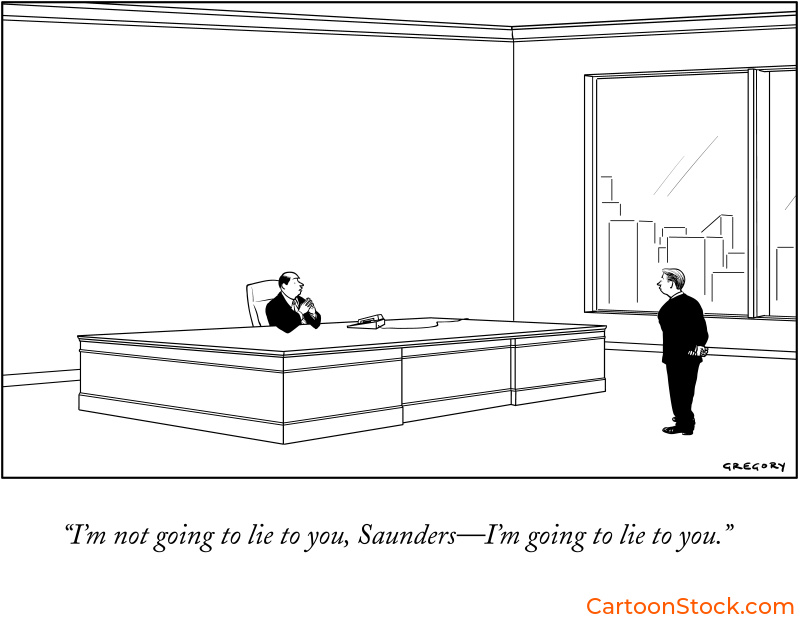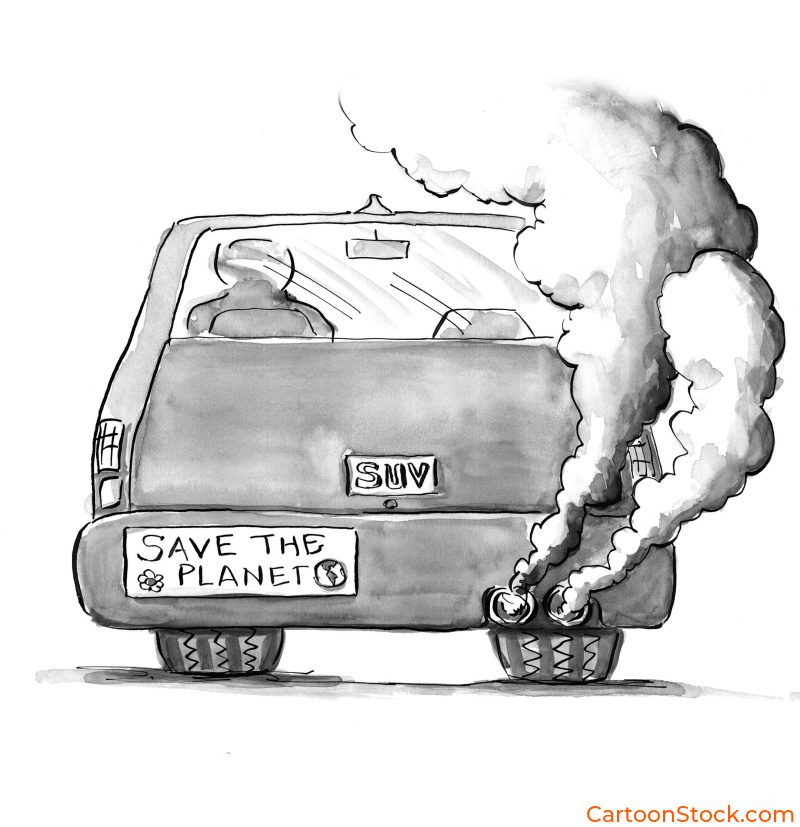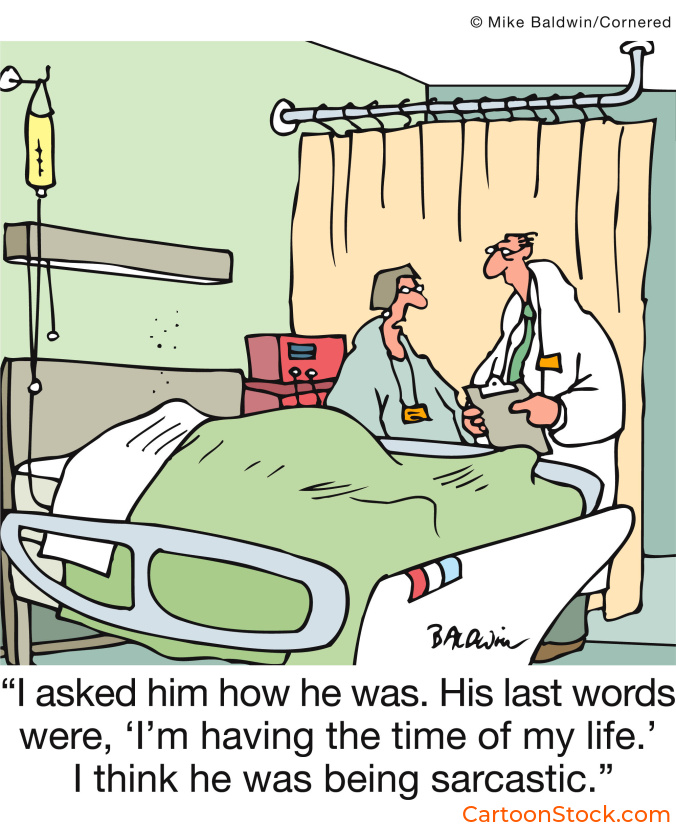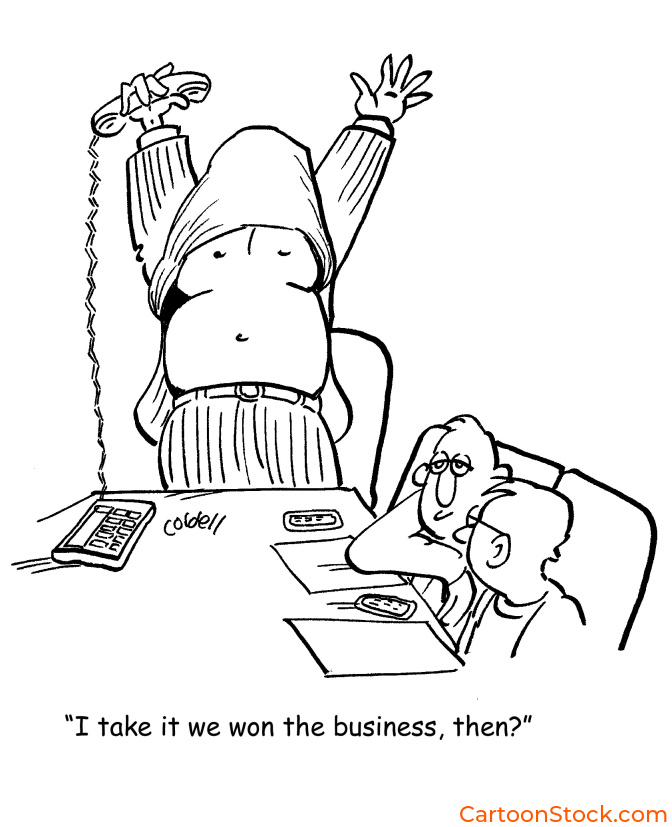Usually, when a person is joking, it’s obvious. The person is smiling, and their face is animated and happy. But for “dry humor,” this ‘I’m telling a joke face” is a no- no. The joke must be delivered totally deadpan.
Dry humor requires both regular smarts and social intelligence. That’s why is both used and appreciated by those who have both. In dry humor, language is doing the work. No props or physical antics allowed. Dry humor uses wording that must be decoded, which is too much effort for people who like their humor puzzle free. In other words, you must do some brain work to get the joke.

Some Elements of Dry Humor
Dry humor is humor wearing the mask of seriousness to get laughs from irony, understatement, and sarcasm. Let’s look at all three of these contributions along with some cartoons because, well this is a cartoon blog.
Irony
One form of irony is when we say is the opposite of what we mean or feel, like commenting “what a beautiful day” when it’s raining. That might have been funny the first time it was said way, way back when, but it has lost a bit of its punch by now.
However, if a torrential rainstorm flooded your basement and you said with a straight face, “Well, we always wanted an indoor pool,” that would be an example of dry humor with some real humor. The irony in cartoons is a bit different. It’s situational irony where for example an insomniac reads a book on sleep hygiene that keeps him awake. Whenever what you’re doing produces the opposite result of what you’re intending you have the potential situation irony. Here’s the potential realized in a cartoon.

Sarcasm
Sarcasm is irony’s cruel twin. It’s irony in the insult mode. Like irony, you’re voicing the opposite of what is meant, often seeming to praise while ridiculing. Examples: Remarking “Nice job” when it’s botched; calling someone “Sherlock’ who has a firm grasp of the obvious, and saying “No kidding, Einstein” as a substitute for ‘duh.” See if you can detect whose being insulted in this cartoon.

Understatement
Something can be made funny either by exaggeration or by its opposite, which is called understatement. Dry humor doesn’t use hyperbole. There are no dry humor jokes that start “Yo Mamma’s so fat….”
Here’s a cartoon example of understatement..

The benefits of having a dry sense of humor
Dry humor can be useful in defusing tense situations where emotions are running high exactly because it is delivered without emotion. Let’s say you cut someone off in traffic, and then at the light they pull up next to you, angry and screaming. Don’t scream back. Wait until they’re finished, then say deadpan “I can tell you’re upset. Do that, and they might laugh. Or slash your tires. Well, you can’t win ‘em all.
Dry humor is not everyone’s cup of tea that’s why we have coffee, and people who get laughs by splitting watermelons open with sledgehammers. And, when I’m not off hacking watermelons with hammers for yuks, I enjoy using laid-back humor for laughs.
Here are some real-life examples where I used dry humor and it was enjoyed greatly by me and no one else.
Once at a Starbucks when they asked me for my name I said, “My name is Steve but that’s not my real name”.
At the supermarket when asked “paper or plastic” I said “Neither, I’m going to eat all this right here.” In both cases, I think there was a moment when they thought “do I have to call security on this guy”. Well, they didn’t once I gave them my big “don’t call security on me” smile.
How to develop a dry sense of humor
Some people say you need to be born with a talent for dry humor but those are just people who are born with it and don’t want anyone else to get it. Well, too bad on them because if you want it is a skill that can be learned. Here’s how:
First, start by paying attention to the things that make you laugh. Watch comedy shows, read funny books, and listen to comedians. The more exposure you have to all kinds of humor, the more likely you are to develop a dry sense of humor. Sometimes dry humor is just wet humor toned down.
Second, try to be more aware of the way you speak when joking. The natural tendency is to mug and give lots of vocal and facial cues that a joke is coming. Eliminate all of that and if you can add some understatement and irony, you’re on the right track.
Third, dry humor requires you to avoid over-explaining your jokes and being not only ok with people not getting them but actually getting a kick our of their befuddlement.
Fourth, learn from the masters.
YouTube is great for this. David Letterman, Steven Wright and Mitch Hedberg are masters of the form. As you go through your day imagine you are Dave, Steven or Mitch and think of how they would react to situations with poker faced irony or understatement.
Then try it out yourself in low-risk situations like with friends, family, or pets. If you’re not careful dry humor can come off as mean-spirited and rude so use it sparingly at first before you make a fool of yourself at a Starbucks or the supermarket.
Fifth, express your taste in dry humor with cartoons. As demonstrated throughout this article, cartoons are a great way to express dry humor because they often rely on irony, understatement, and sarcasm to get their point across. Plus they do all the heavy lifting for you. And with over half a million cartoons, Cartoonstock is the place to be to find cartoons on any topic imaginable.

